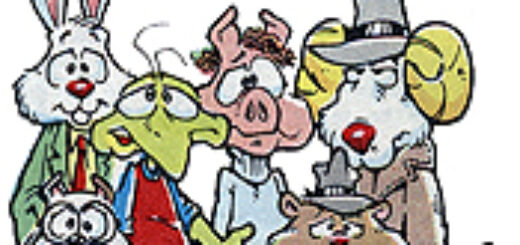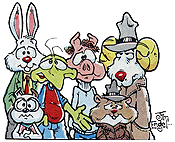Emily S. Whitten: Heroism and Bravery
 Some people think that comics are a kid thing – the bright colors; the often cartoony style of art; the people parading around with their underwear on the outside – and they are for kids. But they’re also for teens, and adults, and all of us. They are a medium of storytelling that can be just as beautiful and terrible and effective as any other. If done right, the stories within a comic can bring joy, and can hurt, and inspire, and educate, and much more.
Some people think that comics are a kid thing – the bright colors; the often cartoony style of art; the people parading around with their underwear on the outside – and they are for kids. But they’re also for teens, and adults, and all of us. They are a medium of storytelling that can be just as beautiful and terrible and effective as any other. If done right, the stories within a comic can bring joy, and can hurt, and inspire, and educate, and much more.
It’s funny when I try to talk about comics to someone who doesn’t read them, like my dad. His first response is “We didn’t have those in my house growing up. Some of the other kids did, I guess.” You know – because it’s a kid thing. Don’t get me wrong. He’s not criticizing my love of comics; he just hasn’t read many, and might not be aware that they can contain nuanced and complex storytelling, both for kids and adults. But I’m a well-read adult, and comics engage me, they bring me joy, they make me laugh, and yes, sometimes, they even make me cry. I know I’m not the only one.
In today’s hyper-connected society full of Internet news and forums and blogs, we know, more than we might have in the “old days,” that there are tons of us adult comics fans out there, and that, indeed, at least in media like movies, comics have gone mainstream – people who’ve never read a paper comic have watched movies about Superman and Spider-Man and the X-Men and The Avengers and Batman and all the rest. Parents of children who are themselves adults have gone to see these movies. These days, as pointed out in John Cheese’s article, if you don’t get excited about the newest comics movie, or aren’t planning to see it, people might even think you’re out of the loop. Everyone now has exposure to comics, and all of us adult fans know we are not alone.
We also know that even though comics are a pretty big thing these days, there are still going to be people that think they’re only for kids, and/or don’t see the value within. There are also going to be people who look at art of Spider-Man in mid-fight and only see people beating up on each other. And they’re going to be concerned (maybe for the kids, or maybe because of the violence in general) and think that comics don’t hold much value, or that they are a bad influence. But Spider-Man landing a punch is only part of the story.
In the wake of the horrible and senseless Dark Knight Rises shooting tragedy, I know people are already questioning whether comics (and their affiliate media, such as movies) were responsible for the violence, and how violence in comics is affecting people, including children. I also know that comics creators and fans are trying to understand how a man who was presumably at least some sort of a fan could have done such a terrible thing. I certainly don’t know, except that quite probably, he is mentally ill.
Having studied media in culture way back in the dark ages of college (was it really so long ago??) I know that we don’t know, and probably won’t ever know, exactly how much influence violence in media has on people, although we do know that there can definitely be a correlation. But by the same token, we also know that two people being exposed to the same violent media can have completely different reactions, and for some people, there may be no correlation at all. For the majority of society, seeing a violent movie, or reading a violent comic, doesn’t directly cause violence; otherwise we’d have a lot more tragedies like this recent one.
I don’t believe we will ever be able to definitively answer the “effects of violence in media” question. Does that mean we should just shrug our shoulders and give up on our studies of this issue? Of course not. But at least at this point in our cultural learning, we don’t know what exact factors may have caused a man to methodically plan to shoot into a crowded theater. And although the news is reporting that the man said he was the Joker and had dyed red hair (presumably to emulate the Joker in the hospital nurse scene of The Dark Knight), I don’t think that necessarily means that Batman comics or movies caused him to do what he did. They may have narrowed his focus of where to attack people, and that is awful; but if The Dark Knight Rises hadn’t been there for this man to focus on, I’m guessing he would have found some other place to focus his violent acts.
I also think that as long as any kind of popular media, including comics, exists (which it always will) there are going to be some stories that may need to include violence in order to make their point, and there are going to be people out there who will miss the point of all of the complex and nuanced storytelling we can possibly include, and only see the violence; whether it be a concerned parent, or a politician, or a news reporter, or tragically, a man who thinks violence against random people in a theater is okay. But that isn’t a reason to censor necessary elements of storytelling.
Yes, Batman as a character can be violent; but as my friend Cleolinda Jones said about The Dark Knight Rises, “The sad thing about this theater tragedy is, the major theme of the movie is about inspiring others to stay strong and do good, even in the face of tragedy.”
As comics creators, I think the best we can do regarding the “violence in media” issue is continue to create nuanced stories which frequently show the good in our characters, and hopefully inspire readers with messages like staying strong and doing good, or helping others; and in which any violence is included because it is necessary to the point of the story, and does not champion violence for the sake of violence or as something without consequences. As fans, I think it’s important to tell people about the parts of the stories that move us or inspire us to be better people.
In that vein, here are just a few snippets of stories that I think show the goodness, heroic sacrifice, and bravery that is almost always present in comics. (Caution: Potential random STORY SPOILERS BELOW.)
Spider-Man: During the Marvel Civil War storyline, after years of actively and carefully protecting his identity, Spider-man bravely unmasks on national television as a gesture of support for the Superhuman Registration Act, despite his discomfort with the idea and his fear for his loved ones (who he takes steps to protect first). He makes this choice because he thinks, like Iron Man, that the Registration Act is the best way to protect American citizens and the superhero community.
That in itself would be pretty brave, but later, after Spider-Man discovers the extreme and unjust measures that are being taken to capture and imprison “rogue” superheroes whose only wrongdoing, in many cases, was helping people without registering, he switches sides to fight against the Registration Act, even though he nearly dies because of it. That’s an admirable devotion to doing what’s right.
Richard Mayhew: In Neil Gaiman’s Neverwhere (adapted for comics, which is where I first became familiar with it), Richard Mayhew, a young businessman with a steady job, a flat, and a fiancee, stops to help what looks like a homeless woman who is lying injured in the street. Despite his fiancee’s protests, he takes the woman home (she insists he not take her to a hospital) and cleans her wounds. Unfortunately, helping this scruffy woman causes him to become invisible to regular Londoners, and visible only to the “London Below” of which the woman, Door, is a part. Naturally he panics at first, but then he stays with Door to help her escape the assassins who have killed her family and are hunting her down. There is a fair amount of violence and death in this story; but ultimately, it is about a hero’s journey, and helping others in need, and that is the part that stays with you.
Deadpool: Come on, you knew I’d include Deadpool. The ultimate screw-up most of the time, in Joe Kelly’s run, Deadpool is sought out as a predicted savior of the world. After a lot of scoffing, Deadpool finally believes that maybe, just maybe, he can be the hero he keeps trying to be, and throws himself into getting ready for his new role, where he is to destroy a monster who will arrive to stop the Mithras, a being who will supposedly bring good to all mankind.
As it turns out, what the Mithras brings is bliss in the form of a loss of free will; and after agonizing over the choice of giving mankind blissful but blank happiness, or protecting free will, Deadpool defeats the Mithras and saves the world. He is utterly broken by his choice – the fact that he had wanted so badly to be a hero, and yet had still, through his (heroic) choice, brought the continued pain and suffering that goes with free will to the whole world. But he did it anyway, because it was the right thing.
Barbara Gordon (Batgirl/Oracle): In her earlier years, Commissioner Gordon’s daughter trained herself as Batgirl so that she could fight crime like Batman, and she did so for awhile. However, by the time of Batman: The Killing Joke, she is semi-retired, and at home when the Joker comes to the door and shoots her, which causes her to be paralyzed. After spending some time in deep depression (as you would), Gordon rallies and decides to use her mental gifts (such as her intelligence and photographic memory) to help fight crime instead. She develops a complex computer system, uses her photographic memory to read dozens of news sources every day, and turns herself into an invaluable resource for Batman, the Birds of Prey, and other superheroes. She pushes past her own trauma to continue helping others.
Iron Man: During Marvel’s Dark Reign storyline, Norman Osborn (the Green Goblin) tricks the government into thinking he’s a reformed villain, and they replace Iron Man with Osborn as head of S.H.I.E.L.D. To keep the mentally unstable and untrustworthy Osborn from acquiring superheroes’ identities from the Registration Act database, Iron Man destroys all copies, but still has one remaining copy in his computer-like brain. To protect the information from Osborn, Stark, as a fugitive, goes tirelessly from one location to another, deleting the knowledge from his brain bit by bit. He knows this will also lead to the loss of his highly valued intelligence, and will eventually cause brain damage, but chooses to sacrifice himself to protect others. That’s heroic.
Batman: Since I’m not as big a reader of DC Comics, the live-action more immediately comes to mind, and naturally, right now, specifically the Christopher Nolan version – but there is so much to Batman generally, and in Christopher Nolan’s Batman movies, about sacrifice, and bravery, and doing what’s right, that if I threw a dart at the script (or the comic) I’d hit an example. Essentially, Batman’s whole story is about sacrifice – he’s not a superhero with superpowers, but rather just a rich dude who had a tragic thing happen to him. Yet he chooses to turn that experience, and his resources, into something that can constantly help others and his home city, by training his body and mind and developing and perfecting his gadgetry so that he can use both to fight crime. And in the movies, every time he chooses to protect his identity by turning his public self into something neither he nor others would respect; or takes a beating to foil a villain; or what-have-you; he’s showing that it doesn’t take superpowers to be a hero, or to protect and help people.
The above are just a few examples I happened to be thinking of. But comics are so full of examples that if you read almost any storyline you’ll find them in spades. And although as with many stories, sometimes reflections of real-world violence have a prominent place in the storylines, the violence is not the point of the story – the heroism and bravery of the protagonists is. Those things are the things that stay with most of us, and the things that make me and so many others love these stories.
I don’t know why a few of us miss the point, but I am saddened by it, and I am more saddened by this recent tragedy, and whatever connection it may have had to what is, for the most part, the wonderful world of comics. My heart goes out to all of the victims, and to everyone affected by it – which is all of us.
Until next time, Servo Lectio.
WEDNESDAY MORNING: Mike Gold






 Marvel provided us with the cover and pages from Mighty Avengers #21, written by Dan Slott and drawn by Young Gun artist Khoi. The issue is described as beginning a bold new era for the Mighty Avengers. Spinning out of Dark Reign, the Mighty Avengers have an all-new line up and an all-new missionm, guest starring the New Avengers, Dark Avengers, Young Avengers and Classic Avengers.
Marvel provided us with the cover and pages from Mighty Avengers #21, written by Dan Slott and drawn by Young Gun artist Khoi. The issue is described as beginning a bold new era for the Mighty Avengers. Spinning out of Dark Reign, the Mighty Avengers have an all-new line up and an all-new missionm, guest starring the New Avengers, Dark Avengers, Young Avengers and Classic Avengers. After breaking the news via the Washington Post, Marvel has finally begun to reveal some of the details behind the Black Panther revamp coming in February. T’Challa, the reining Panther, seems to be replaced by a mysterious female. Now, Marvel says T’Challa’s fate is tied to events in the aftermath of Secret Invasion and connected to Dark Reign, 2009’s new crossover event.
After breaking the news via the Washington Post, Marvel has finally begun to reveal some of the details behind the Black Panther revamp coming in February. T’Challa, the reining Panther, seems to be replaced by a mysterious female. Now, Marvel says T’Challa’s fate is tied to events in the aftermath of Secret Invasion and connected to Dark Reign, 2009’s new crossover event. Now that Batman RIP has wrapped up, comic readers are turning their attention to the conclusion of Marvel’s Secret Invasion. The Skrull invasion of Earth will be resolved, setting the stage for a new status quo on Marvel’s Earth to be explored in 2009’s Dark Reign event.
Now that Batman RIP has wrapped up, comic readers are turning their attention to the conclusion of Marvel’s Secret Invasion. The Skrull invasion of Earth will be resolved, setting the stage for a new status quo on Marvel’s Earth to be explored in 2009’s Dark Reign event. 


 Marvel today released this teaser image for the next big event, Dark Reign, just weeks before Secret Invasion #8 is released, ending the current big event. New Avengers: The Reunion was mentioned as a new title at an Ireland convention but no details are known.
Marvel today released this teaser image for the next big event, Dark Reign, just weeks before Secret Invasion #8 is released, ending the current big event. New Avengers: The Reunion was mentioned as a new title at an Ireland convention but no details are known. Marvle this morning released a teaser for a new event in the Marvel Universe. No creators, timing or content was released with the teaser. We’re going to guess that it maybe a part of the 2009 Dark Reign event spinning out of the end of Secret Invasion. It does not resemble the future Iron Men seen in last week’s New Warriors. Any guesses?
Marvle this morning released a teaser for a new event in the Marvel Universe. No creators, timing or content was released with the teaser. We’re going to guess that it maybe a part of the 2009 Dark Reign event spinning out of the end of Secret Invasion. It does not resemble the future Iron Men seen in last week’s New Warriors. Any guesses? Marvel has issued a release indicating the final issue of Secret Invasion will now be in store the first week of December, a week later than anticipated.
Marvel has issued a release indicating the final issue of Secret Invasion will now be in store the first week of December, a week later than anticipated. Rather than the usual "Cup of Joe" panel, Marvel decided that Baltimore Comic-Con would feature "Cup of B." Marvel super-star Brian Michael Bendis appeared, alongside Dan Slott (Avengers: Initiative), Steve Savolski (X-Infernus) and executive editor Tom Brevoort.
Rather than the usual "Cup of Joe" panel, Marvel decided that Baltimore Comic-Con would feature "Cup of B." Marvel super-star Brian Michael Bendis appeared, alongside Dan Slott (Avengers: Initiative), Steve Savolski (X-Infernus) and executive editor Tom Brevoort.








